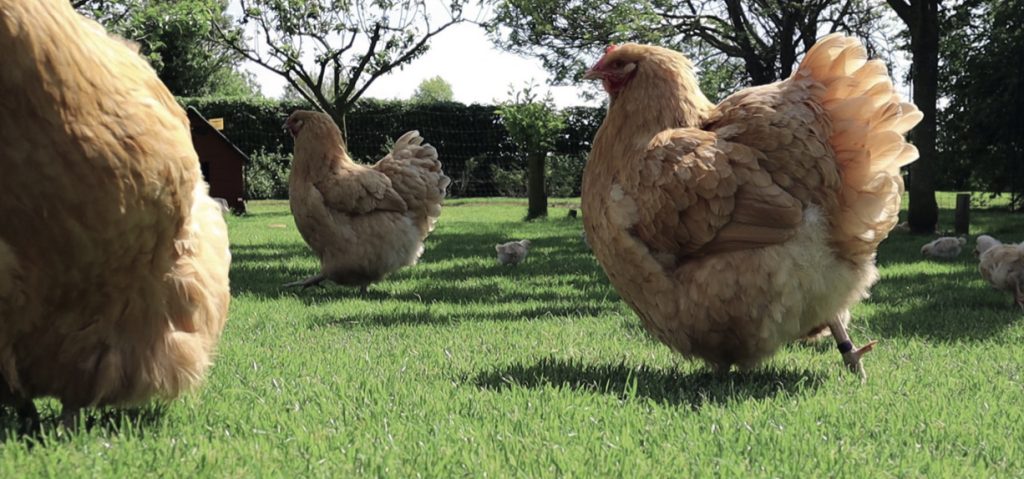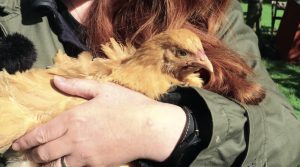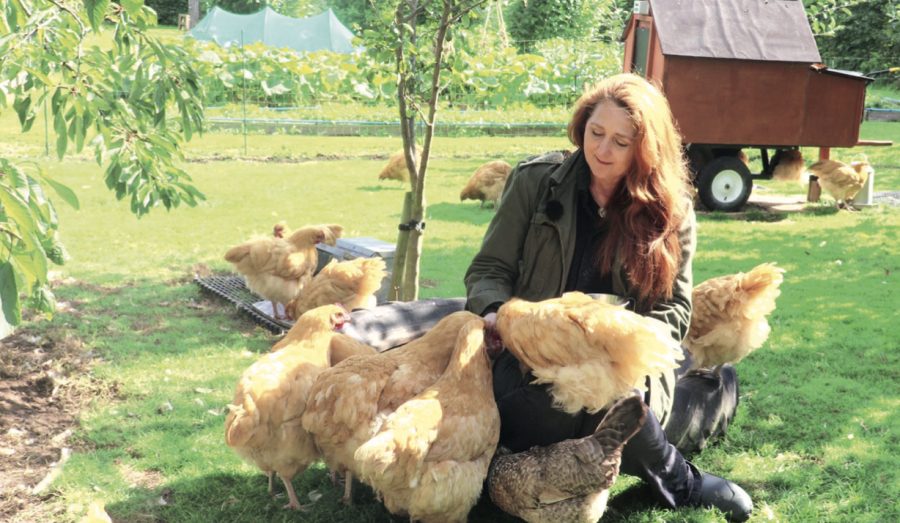Hugh and Fiona Osborne look at the top tips to help you select the healthiest birds for your flock.
TIP NO.1: RESEARCH YOUR SELLER
Sellers can be one of three different types. The first are the large commercial hatcheries that are run for profit. Many of these operations don’t sell to the public
so they will use re-sellers, the second type of seller. The re-sellers essentially take delivery from the hatcheries of hens once they reach a certain age for passing on to the public. The third type of seller is the smallholding or hobby breeder where they breed a small number each year and sell on the chickens they choose not to keep.
Which is of the three is best? Well, to be honest, there’s good and bad in all three so it pays to do research. For commercial hatcheries and re-sellers there will be a website and for smallholders/ hobby breeders they will have social media or an advert on seller platforms such as Preloved.com.
What are you looking for? We would be looking for two things. The first would be the conditions they are hatched and raised in. They should be clean and hygienic with plenty of space for the youngsters. The second thing we would look for are the behaviours of the chickens. Ideally, they should be alert and engaged. What should ring alarm bells is if you see any chickens hunched over or cowering away from the camera.
It’s also worth searching any reviews of the seller. Commercial operations and re-sellers may have been reviewed on independent websites or could be mentioned by other buyers on social media forums. If a previous buyer has been unhappy with the chickens they have bought (for example, if they quickly became ill or were infested with mites), they may have posted it somewhere. It’s possible that they also indicate how good or poor the customer service was once a problem was found.
Of course, you could choose to rehome some commercial egg-layers as a fourth option. The British Hen Welfare Trust has lots of great information on their website hen adoption page (www.bhwt.org.uk/hen-adoption/hen-adoption-faqs/). The information on this page is invaluable in preparing anyone new to rehoming these hens including how to support them, the housing they need, their health needs and what to expect on the day of collection. Anything you’re unsure of, the teams at the charity are incredibly helpful.
 TIP NO. 2: TALK TO THE SELLER
TIP NO. 2: TALK TO THE SELLER
We highly recommend that you make contact with the seller you’ve chosen and ask them some questions to ensure you’re getting the best quality and healthiest chickens.
We would recommend asking about the genetics of the chickens i.e., has an unrelated cockerel been used for breeding. If a related cockerel has been used in breeding, then it’s more likely that there may be genetic problems. Ideally there should be an unrelated cockerel used every year. If you’ve selected a re-seller, it’s possible they won’t know the answer so in this case, your research and reviews are very important as persistent physical issues could indicate poor genetic planning.
It’s a good idea to ask about the bio-security arrangements that they have in place. Most sellers will have a number of people buying chickens, which could increase the risk of diseases or pests being passed onto the stock. Bio-security measures are designed to reduce these risks. Ideally, they will ask if you already keep chickens and if you do, they’ll ask you to wear freshly laundered clothes and shoes that are not worn around your flock. They may also ask you to use a disinfectant foot scrub to further reduce the risk of contamination.
There are some health-related questions that are a good idea to pose. It’s worth asking if there have been any recent incidences of illnesses or pests on their site or local area.
With illnesses, such as Avian Influenza or Mycoplasma for example, you should establish the nature and longevity of the illness. Some can be very difficult to eradicate and others may be easily resolved.
With pests such as Red Mite, Northern Fowl Mite, Scaly Leg Mite or Chicken Lice it’s important to remember that any long-term chicken keeper is unlikely to experience an outbreak of at least one type of pest at some point. What is important is that there have been no recent incidents as you might be bringing those home.
If the chickens are over 16 weeks old, we’d recommend asking if the chickens have been wormed. If the hens are younger than this they won’t have been treated.
If once you’ve asked these questions, and you’re happy to proceed it’s worth asking what the chickens are used to in term of food, feeders and drinkers. Your youngsters may be used to chick crumb or growers’ pellets, mash or even a specific brand of food. With their feeders they may be used to an open feeder and you have a treadle feeder or vice versa and you’ll need to make adjustments for your youngsters. The same is true for drinkers. A nipple drinker is very different to a tripod drinker and your youngsters may need help to recognise a new format. Knowledge of what is familiar to them helps you to prepare.
TIP NO. 3: DON’T WORRY ABOUT HOW YOU ARE ASKED TO PAY
I have spoken to many chicken keepers over time who have been concerned about a seller because they have asked for either payment in full in advance, a deposit in advance or even payment on collection. For various reasons the buyers are suspicious as it wasn’t what they expected. Payments in advance or deposits in advance might make you suspicious because you feel you’re being tied in before you’ve had time to inspect your chickens. Payment on collection might make you suspicious because you feel as though your chickens will be allocated to someone else.
Our advice is simply that the method of payment has no impact on whether the seller is good or bad. It only reflects the seller’s business model. Whether you are going to get healthy chickens or if you can trust the seller can only be assessed through our other top tips!
TIP NO.4: BE PREPARED TO COLLECT YOUR CHICKENS
The first thing to think about is the length of your journey, as your journey should be as short as possible to reduce the stress on your new chickens. Everyone knows that dogs on a long journey should have breaks for water and food and should not be left unattended in a car, particularly on a hot day. It’s exactly the same for chickens. They will need food and water on longer journeys and can overheat very quickly in a hot car causing them distress, just like a dog. We refused to sell to one buyer who wanted to pick up her chickens and then take her kids to a local seaside town on the way home.
Although it’s a necessity for longer journeys, we would recommend that for every journey you should take some water and a drinker as well as some food for them. On a short journey, it might not be needed, but it does ensure your chickens aren’t left dehydrated or hungry if there is a problem on the way home (traffic jam, accident, breakdown). Our motto is it’s better to have it and not need it than need it and not have it, particularly where animal welfare is concerned. If you’re not sure if your chickens might be thirsty or hungry, pull over. It’s OK to keep checking if you’re not sure and it’s certainly better than the alternative!
It’s good to be aware that your chickens won’t recognise you, will be in a strange environment and as a result will be frightened when you give the food and water to them, as a result, be prepared for a break for freedom. It might be an idea to have the doors and windows shut when you give them the food and water!
We’ve jumped ahead, but the message about planning your journey so your chicken’s welfare comes first is something we feel very strongly about. Let’s go back to the pick-up itself.
To collect your chickens the first thing you need is something to put them in for your journey. Your carrier should allow the chickens enough floor space and height that for the journey they are not cramped and uncomfortable. The ideal solution is a specialist poultry crate but if you don’t have one, you don’t need to buy one, there are lots of suitable alternatives out there. If you have a dog crate or large dog carry case, that will be suitable. Failing that a good-sized cardboard box with some air holes will very adequately do the job. We would advise taking some tape to secure the top once the chickens are inside as well as consider putting something absorbent in the bottom as it’s likely they’ll poop on the way home, in fact consider putting a tarpaulin or a boot liner underneath them.
Of course, once you know the carrier you’re going to use, make sure the vehicle that you’re going in can accommodate the carrier and you can get it in and out without causing your chicken’s distress. If you have to load it on an angle or jostle it into place, you might need to borrow a more suitable car or rethink your choice of carrier.
If you are a new chicken keeper and not confident yet about handling the chickens, ask the seller to help you. They should be able to transfer your chickens
to your carrier/box for transport with confidence so your chickens are not fearful or suffering. If you see mishandling, for example holding the chicken upside down by the legs, it’s OK to walk away. It ties into Tip No.5 where you’re verifying that the seller is one that you’re confident about as a reputable breeder.
The best thing to keep your chickens calm for the journey home is to keep them in darkness. This is very calming for them and makes them think it’s roosting time as chickens are very much ruled by their circadian rhythms. How do you do this? The simplest thing is to pull the boot cover over their carrier.
The final thing to consider for the journey is the possibility that your box or carrier containing your chickens slides every time you turn a corner. This is easily solved by securing the box/carrier in the boot with either bungee cords or use something to wedge the box in place.
 TIP NO.5: VERIFY YOUR RESEARCH WHEN YOU ARRIVE AT YOUR SELLER
TIP NO.5: VERIFY YOUR RESEARCH WHEN YOU ARRIVE AT YOUR SELLER
When you finally arrive at your seller’s site, it’s important to verify everything you’ve learned so far. Do the pictures on the website represent what you’re actually seeing? Are the chickens that you see clean and active?
It’s possible the chickens may be in a separate viewing area from where they normally live. This is what we do. We do this for two reasons. The first
is that we reduce the stress on the chickens by separating any chickens due to be collected at roosting time so that we’re not chasing them around our field upsetting them. The second reason is that it maintains a level of biosecurity as we don’t allow visitors to enter the main chicken enclosure. Having said that, it’s worth ensuring that you can see where the chickens normally live. We always encourage our buyers to view the field from outside of the electric fence. This gives the buyer the assurance of the conditions they are raised in without compromising our bio-security. If you’re not allowed to view where they are raised, why not? Never forget that it’s OK to leave if you’re unhappy in any way.
TIP NO.6 PERFORM SOME BASIC HEALTH CHECKS
It’s always a good idea to inspect chickens before taking them away as not only are you safeguarding the long-term health of your chickens, but it’s a good idea to ensure that they are fit to travel. What are you looking for?
The first thing to look at is the condition of their feathers. If the feathers are in good condition, it means the hen is looking after herself. This is a good first indication of good health.
The chickens’ eyes, nose and beak are next. Do they have clear eyes, without discharge, cloudiness or the inner eyelid closed over? Is the nose and beak clear of discharge?
Next, check the legs, looking for healthy, flattened scales on the legs. Raised scales may indicate the presence of Scaly Leg Mite.
One of the most important areas of the chickens to check is the vent which should be clean and clear. It is possible that if your chickens have been waiting for you in a carry case, they may have sat in some faeces but it should be easy to differentiate between sitting in fresh poop while they wait and dry matted faeces which may indicate a longer-term health issue.
The vent is where you’ll start to check for Chicken Lice and the presence of Red Mite or Northern Fowl Mite. If you see what looks like a grey powdery deposit around the base of the feather shaft it indicates Chicken Lice as the grey deposits are the eggs of a Chicken Louse. Just remember to look for grey not brown as you might see brown earth particles left over from the chicken’s last dust bath!
At the same time look for any movement, such as tiny black dots (Northern Fowl Mite) or red dots (Red Mite). We’d also recommend looking for movement in the join of the leg and the chicken’s body as it’s warm and comfortable for these mites.
To receive regular copies of The Country Smallholder magazine featuring more articles like this, subscribe here.
For FREE updates from the world of smallholding, sign up for The Country Smallholder newsletter here.








